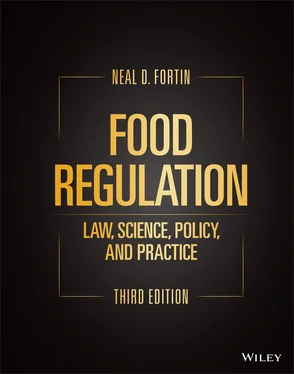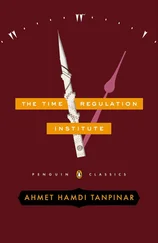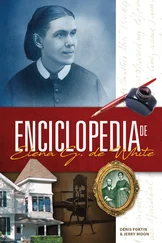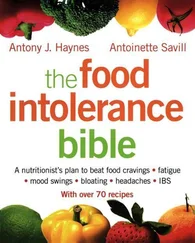Neal D. Fortin - Food Regulation
Здесь есть возможность читать онлайн «Neal D. Fortin - Food Regulation» — ознакомительный отрывок электронной книги совершенно бесплатно, а после прочтения отрывка купить полную версию. В некоторых случаях можно слушать аудио, скачать через торрент в формате fb2 и присутствует краткое содержание. Жанр: unrecognised, на английском языке. Описание произведения, (предисловие) а так же отзывы посетителей доступны на портале библиотеки ЛибКат.
- Название:Food Regulation
- Автор:
- Жанр:
- Год:неизвестен
- ISBN:нет данных
- Рейтинг книги:4 / 5. Голосов: 1
-
Избранное:Добавить в избранное
- Отзывы:
-
Ваша оценка:
- 80
- 1
- 2
- 3
- 4
- 5
Food Regulation: краткое содержание, описание и аннотация
Предлагаем к чтению аннотацию, описание, краткое содержание или предисловие (зависит от того, что написал сам автор книги «Food Regulation»). Если вы не нашли необходимую информацию о книге — напишите в комментариях, мы постараемся отыскать её.
Food Regulation: Law, Science, Policy, and Practice
Food Regulation: Law, Science, Policy, and Practice, Third Edition,
Food Regulation — читать онлайн ознакомительный отрывок
Ниже представлен текст книги, разбитый по страницам. Система сохранения места последней прочитанной страницы, позволяет с удобством читать онлайн бесплатно книгу «Food Regulation», без необходимости каждый раз заново искать на чём Вы остановились. Поставьте закладку, и сможете в любой момент перейти на страницу, на которой закончили чтение.
Интервал:
Закладка:
1.2 A SHORT HISTORY OF FOOD REGULATION IN THE UNITED STATES
1.2.1 Why Do We Have Food Laws?
From the beginnings of civilization, people have been concerned about food quality and safety. The focus of governmental protection originated to protect against economic fraud and to prevent against the sale of unsafe food. As early as the fourth century BCE, Theophrastus (372–287 BCE) in his ten‐volume treatise, Enquiry into Plants , reported on the use of food adulterants for economic reasons. Pliny the Elder’s (CE 23–79) Natural History provides evidence of widespread adulteration, such as bread with chalk, pepper with juniper berries, and even adulteration with cattle fodder. 1 Ancient Roman law reflected this concern for adulteration of food with punishment that could result in condemnation to the mines or temporary exile. 2
Starting in the thirteenth century, the trade guilds advanced higher food standards. The trade guilds, which included bakers, butchers, cooks, and fruiters among the many tradecrafts, held the power to search for and seize unwholesome products.
Indeed, as the guilds policed the marketplace, they were most interested to ensure continued and strong markets for their goods. Nonetheless, the guilds provide an early demonstration how stringent product quality and safety standards can bring a competitive economic advantage to industries and nations. Trust in food’s safety and wholesomeness is necessary for the market to prosper. A number of commentators have noted the commonality of interest between business self‐interest and stringent product safety standards. 3
Regulation of food in the United States dates to the colonial era, but the early food laws were nearly all state and local regulation. Federal activity was limited to imported foods. The first federal food protection law was enacted by Congress in 1883 to prevent the importation of adulterated tea. This was followed in 1896 by the oleo‐margarine statute, which was passed because dairy farmers and the dairy industry objected to the sale of adulterated butter and fats colored to look like butter.
* * * * *
An Early Massachusetts Food Law 4
Passed March 8, 1785
An Act against selling unwholesome Provisions
Whereas some evilly disposed persons, from motives of avarice and filthy lucre, have been induced to sell diseased, corrupted, contagious, or unwholesome provisions, to the great nuisance of public health and peace:
Be it therefore enacted by the Senate and House of Representatives, in General Court assembled, and by the authority of the same, That if any person shall sell any such diseased, corrupted, contagious or unwholesome provisions, whether for meat or drink, knowing the same without making it known to the buyer, and being thereof convicted before the Justices of the General Sessions of the Peace, in the county where such offence shall be committed, or the Justices of the Supreme Judicial Court, he shall be punished by fine, imprisonment, standing in the pillory, and binding to the good behaviour, or one or more of these punishments, to be inflicted according to the degree and aggravation of the offence.
* * * * *
Although adulteration and mislabeling of food had been a centuries‐old concern, the magnitude of the problems increased in the last half of the nineteenth century. This was an era of rapid development in chemistry, bringing advancements in food science, new food additives and colorings, and new means of adulteration. Fortunately, these scientific advances also provided the tools for detecting adulteration.
We face a new situation in history. Ingenuity, striking hands with cunning trickery, compounds a substance to counterfeit an article of food. It is made to look like something it is not; to taste and smell like something it is not; to sell like something it is not, and so deceive the purchaser.
Congressional Record, 49 Congress I Session 1886.
In this era, food production began shifting from the home to the factory, from consumers buying basic ingredients from neighbors in their community, to food processors and manufacturers more often at a distance. With this trend, consumers found it harder to determine the safety and quality of their food. Inevitably, the responsibility for ensuring the safety of foods only shifted from local to state government, and the demand for federal oversight increased. As national markets grew, legitimate manufacturers became concerned that their markets were being harmed by the dishonest and unsafe goods.
1.2.2 The 1906 Pure Food and Drug Act
In 1883, Dr. Harvey Wiley became the chief chemist of the U.S. Bureau of Chemistry (at that time, part of the Department of Agriculture). Dr. Wiley expanded research and testing of food and documented widespread adulteration. 5 He helped spur public indignation by his publications and by campaigning for a national food and drug law. Wiley dramatically focused concern about chemical preservatives as adulterants through his highly publicized “Poison Squad.” 6
The Poison Squad consisted of live volunteers who consumed questionable food additives, such as boric acid and formaldehyde, to determine the impact on health. Observation and documentation of the ill effects and symptoms of the volunteers provided an appalling crude gauge of food additive safety. 7 However, crude by today’s standards, Wiley’s leadership with the galvanize public awareness and advanced food safety.
Public support for passage of a federal food and drug law grew as muckraking journalists exposed in shocking detail the frauds and dangers of the food and drug trades, such as the use of poisonous preservatives and dyes in food and deadly opiate‐laced syrups for children. 8 A final catalyst for change was the 1905 publication of Upton Sinclair’ The Jungle . Sinclair portrayed nauseating practices and unsanitary conditions in the meatpacking industry, such as food handlers sick with tuberculosis and carcasses covered in rat droppings being made into sausage. The book was a best seller, and meat sales dropped by half. 9
Outraged at the conditions described in The Jungle , President Theodore Roosevelt sent his own investigators to the Chicago packinghouses. They found the situation as revolting as Sinclair had described, including witnessing a carcass falling into a latrine, being hauled back out, and put back uncleaned with the other meat. 10 Even though leaders within the meat industry were ready for new rules, Congress refused to pass a bill. President Roosevelt had held back his investigators’ report, but when Congress would not act, he released the report to the newspapers. Soon Roosevelt had his bill. 11
On June 30, 1906, President Theodore Roosevelt signed both the Pure Food and Drug Act 12 and the Meat Inspection Act 13 into law. Passage of these two statutes began the modern era of U.S. food regulation. While neither act could be considered comprehensive, both responded to the concerns of the day.
The Pure Food and Drug Act added regulatory functions to the U.S. Bureau of Chemistry. The Meat Inspection Act of 1906 required the U.S. Department of Agriculture (USDA) to inspect all cattle, sheep, swine, goats, and horses when slaughtered and processed into products for human consumption. The primary goals of the Meat Inspection Act were to prevent adulterated livestock from being processed into food, and to ensure that meat was slaughtered and processed under sanitary conditions.
1.2.3 Evolution of the Food Statutes
Not long after passage of the Pure Food and Drug Act, legislative battles began to expand and strengthen the law. For instance, the act did not prohibit false therapeutic claims, but only false and misleading statements about the ingredients or identity of a drug. Therefore, the Food and Drug Administration (FDA) could take no action against snake oil with an illegitimate claim to cure cancer so long as the product actually was oil from snakes. In addition, leaders in the food industry called for more stringent product quality standards to create a level playing field. Members of Congress called for better safety standards and fair dealing.
Читать дальшеИнтервал:
Закладка:
Похожие книги на «Food Regulation»
Представляем Вашему вниманию похожие книги на «Food Regulation» списком для выбора. Мы отобрали схожую по названию и смыслу литературу в надежде предоставить читателям больше вариантов отыскать новые, интересные, ещё непрочитанные произведения.
Обсуждение, отзывы о книге «Food Regulation» и просто собственные мнения читателей. Оставьте ваши комментарии, напишите, что Вы думаете о произведении, его смысле или главных героях. Укажите что конкретно понравилось, а что нет, и почему Вы так считаете.












